KTM’s 390 Enduro R and Kawasaki’s KLX230 are priced a mere Rs 7,000 apart.
As India’s off-road riding community grows, so does the need for purpose-built but cost-effective machines. KTM’s 390 Enduro R and Kawasaki’s KLX230 offer two vastly different interpretations of what an accessible, dirt-focused bike should be. While there’s a huge gap in their performance, their price tag is where they are quite close. Both claim to be proper off-roaders, but which one truly fits the brief?
KTM 390 Enduro R vs Kawasaki KLX230: Design and features
Both motorcycles are designed to go off-road but take a different approach
The 390 Enduro R may appear like a stripped-down 390 Adventure at first glance, but look closer, and you can appreciate KTM’s effort to keep its design unique. Based on the 390 Adventure platform, it gets a larger 18-inch rear wheel, a smaller 9-litre fuel tank, less bodywork, and off-road oriented tyres. The plastic tank and black panels look a tad budget and don’t seem like they’d age too well.
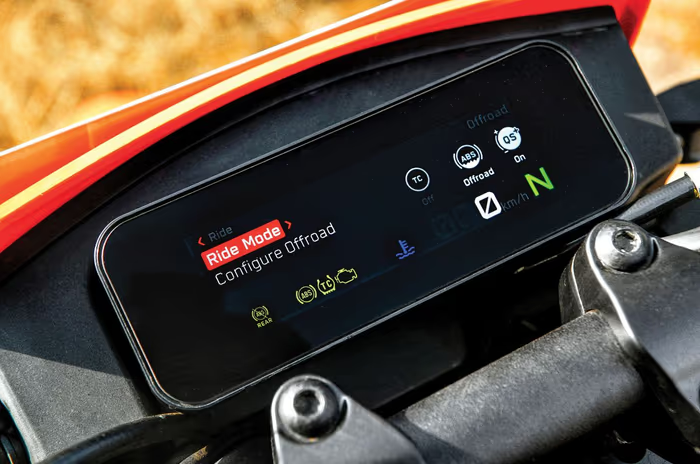
The 4.2-inch TFT on the KTM is packed with information but doesn’t get a fuel gauge
While the dirty white panels give this motorcycle a proper “enduro” aesthetic, the premature discolouration is a bit concerning. That said, the rest of the motorcycle feels solidly built. The switchgear quality is good and feels tactile. The tiny TFT display looks premium, and it shows most of what you’d want to see, except for a fuel gauge, which would’ve been handy while exploring remote trails.
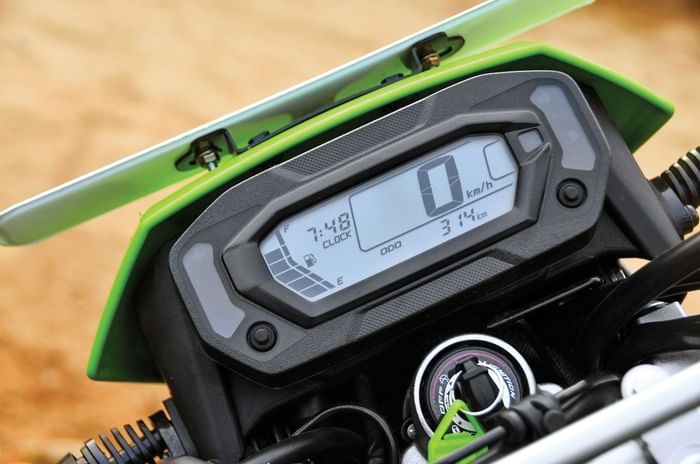
The KLX230’s monotone LCD is quite basic and misses out on a gear position indicator.
In contrast, the Kawasaki KLX230 feels solid and has durable plastics and a no-nonsense design. Discolouration seems to be a common theme, and the KLX230’s dual-tone seat gets dirty fairly easily. It gets an LCD with basic information and a simple layout. While it includes a fuel gauge, it skips a rev counter and gear position indicator – features you will miss but can learn to live without. The switchgear feels budget and a tad rudimentary. It’s also worth mentioning that parts like the mirrors, indicators and levers, which are likely to get damaged off-road, cost significantly more for the KLX as it is a CKD import.
KTM 390 Enduro R vs Kawasaki KLX230: Ergonomics
Both bikes are ergonomically compromised in their own way.
At 860mm, the KTM’s seat height is tall but not extreme, and riders around 5’7” should be able to get the balls of their feet down. The Enduro R has a nicer seat and is the better option if you ever need to ferry a pillion. Standing up on the Enduro R feels more natural, and over time, you’ll prefer riding it on your feet. The Enduro R also offers decent mounting points for luggage, and it will definitely be the better option if you intend to cover bigger distances to get to interesting locations. A noticeable flaw is the engine guard that will bump your knees, nudging you to stand.
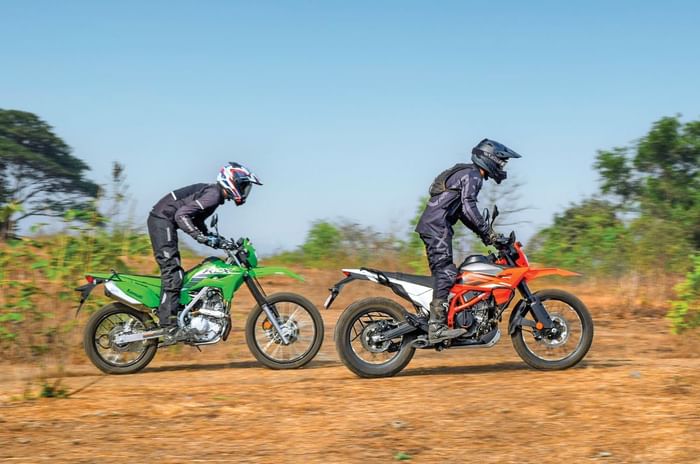
The KTM is better suited for standing up and riding.
The KLX230 has a similarly upright posture, but its ergonomics feel a bit too forward-set while standing, especially for taller riders who will want a higher handlebar. On paper, it has a taller 880mm perch, but once seated on it, the suspension sags enough that even riders around 5’7” can touch down easier than the KTM. However, the narrow and firm standard seat quickly becomes uncomfortable on the road.
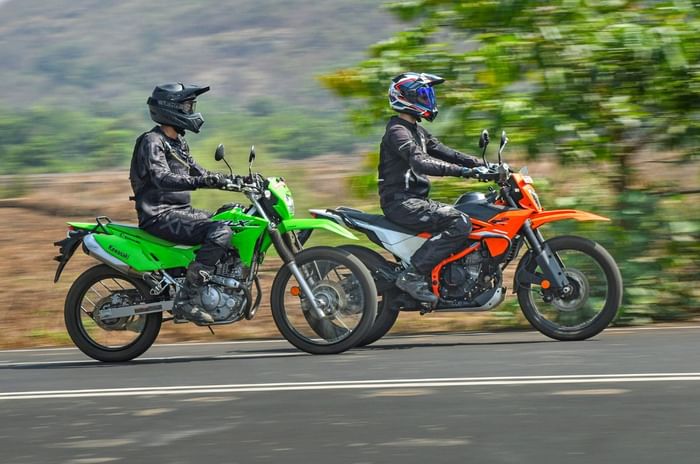
The 390 Enduo R also has slightly better seating ergonomics
The more unusual challenge is getting the KLX230 off its stand – a task that needs to be done with the suspension unloaded, as the rear shock doesn’t allow the side-stand to retract when loaded. There are no built-in mounting points for luggage, but Kawasaki sells an accessory carrier.
KTM 390 Enduro R vs Kawasaki KLX230: Performance and efficiency
The 390 Enduro R outclases the KLX230 by a long shot in terms of performance
This is where the two bikes couldn’t be more different. The Enduro R borrows its 399cc liquid-cooled engine from the other 390s and puts out the same 46hp and 39Nm – more than double the KLX’s peak output. However, on technical trails, this performance can be a bit much. Its motor doesn’t have much of a bottom end and then easily spins up the rear when the revs build. That said, the engine is decently tractable and rides well on the road with the same highway cruising performance as its Adventure siblings.
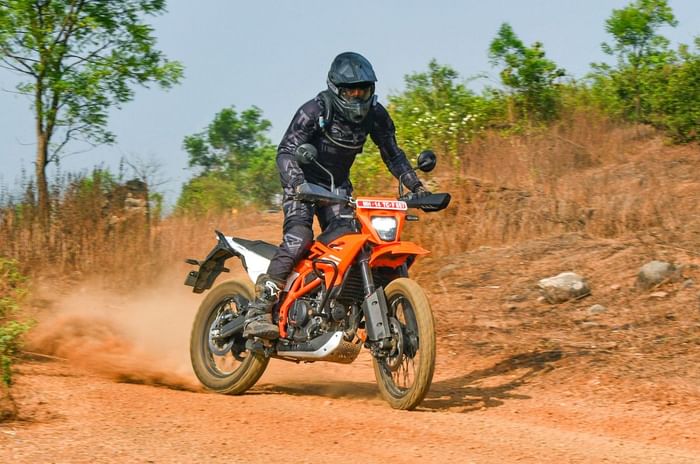
Despite the tame nature, the 390 Enduro R is still a hoot on dirt.
The engine may feel slightly tame for seasoned riders used to KTM’s raw nature, but that makes it surprisingly beginner-friendly. The Enduro R can cruise at triple-digit speeds all day and doesn’t feel out of place in traffic either. With its 9-litre tank, the KTM can achieve about 200km on a full tank in the real world. What makes the KTM even more manageable are its electronics – switchable ABS, a very effective off-road traction control, two riding modes, and a bi-directional quickshifter, all make life easier.
Given the huge difference on paper, you’d expect the KLX230 to struggle, but it keeps up remarkably well off-road. It uses a simpler, smaller engine and there’s no sudden surge, but it has great bottom and mid-range. In fact, we definitely preferred this engine for off-road riding. Naturally, on road, the KTM easily leaves the Kawasaki behind, and anything above 90kph feels laboured; you also need to plan your overtakes.
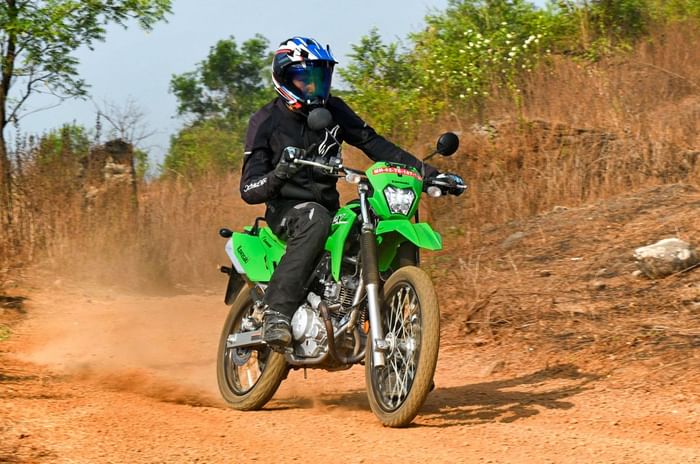
The lack of power allows the KLX230 to feel more stable and predictable off-road.
Surprisingly, when ridden at higher speeds on- and off-road, there was only a 4kpl difference between the Kawasaki and the KTM. This is largely due to the KLX’s smaller engine that needs to work harder, and we often found that it needed filling sooner than the KTM. The KLX has no electronic aids apart from switchable ABS, but truth be told, it doesn’t need any.
KTM 390 Enduro R vs Kawasaki KLX230: Ride and handling
The KLX230 has much better off-road handling than the 390 Enduro R.
The KTM gets adjustable suspension, but the India-spec bike gets reduced suspension travel compared to the export model, and we also found that the damping control can be improved. Ridden over the same rocky trails, the KTM is more bouncy and fights the same surfaces that the KLX glides over, which makes it tougher to manage. Reducing the compression damping to make it more compliant only results in a tendency to bottom out over jumps, so we elected to deal with the bounciness instead.
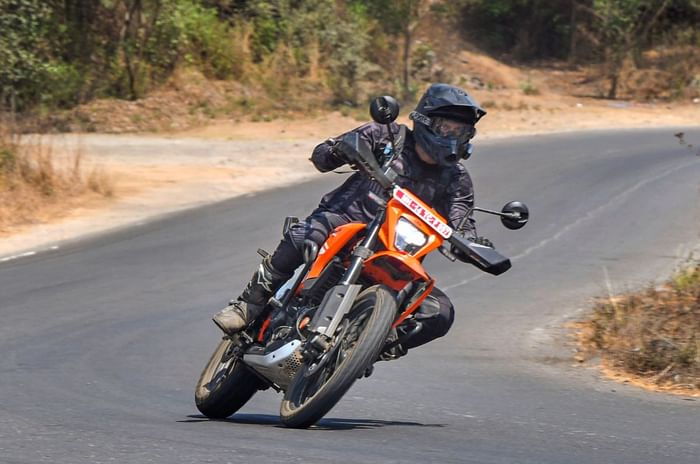
The 390 Enduro R strikes a much better balance between road and off-road handling
In tighter off-road sections, its 37kg weight disadvantage over the KLX also becomes noticeable and demands more from the rider. While the suspension lacks the plushness of the Kawasaki off-road, it shines on the tarmac. The Enduro R resists diving under braking, doesn’t squat under acceleration, and can be hustled in corners like a road bike despite its dual-purpose tyres.
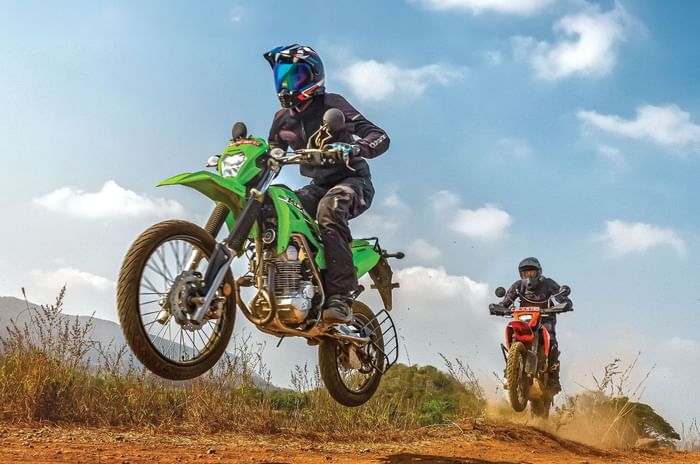
Thanks to the light weight, the KLX230 loves big jumps
The KLX230’s suspension componentry is more basic, but despite that, it is far more capable off-road and soaks up imperfections with ease, giving riders more confidence to explore. It boasts 265mm of ground clearance, but that drops considerably with rider weight. The KLX is also more forgiving of rider mistakes, but push it, and it begins to show its limits, which is a reminder that neither of these bikes can be used for a very high level of off-road riding. On the road, the KLX’s dirt orientation is evident in the excessive front-end dive under braking. Yet, in our braking tests, the KLX was nearly on par with the KTM, thanks to its significantly lighter weight.
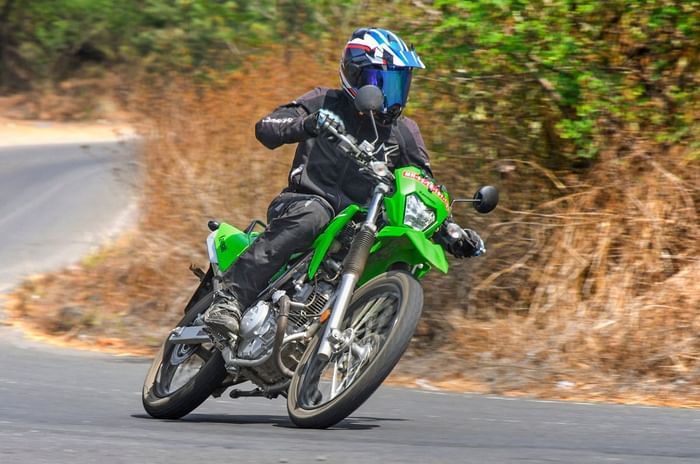
The KLX230 corners surprisingly well
The KLX changes direction easily, and it feels very light and nimble. However, its on-road handling is a bit vague and takes some getting used to. The MRF tyres are not bad, but the Mitas E-07s on the KTM are noticeably better.
KTM 390 Enduro R vs Kawasaki KLX230: Verdict
The KTM offers great value for just an additional Rs 6,000
At Rs 3.30 lakh, the simpler KLX’s value proposition feels a bit lopsided. It lacks features, and its highway manners aren’t comparable to the KTM’s. Kawasaki is reportedly working on a localised version, which could improve the price equation significantly, but that’s still some time away.
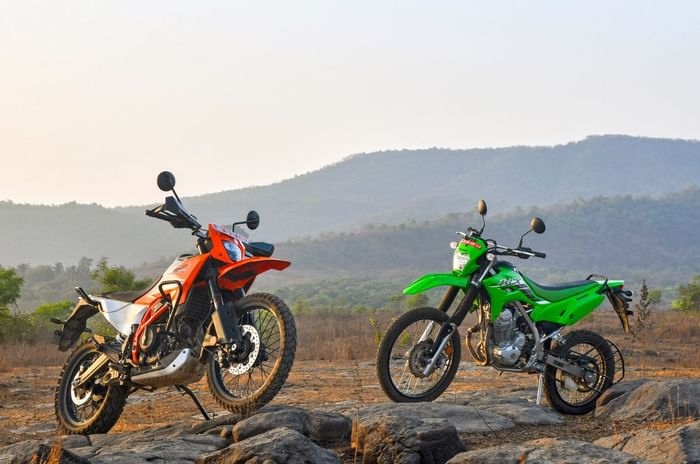
Given the minimal price delta between the two, the 390 Enduro R makesa great case for itself.
Still, the KLX230 is a charming little trail bike, and we enjoyed riding it off-road a lot more than the KTM. It’s unintimidating, lightweight, and promises to be reliable – the kind of machine that lets you explore and make mistakes without punishing you. As a second or third bike, it’s an excellent option. But as a one-bike solution? Only if you’re a true off-road maniac.
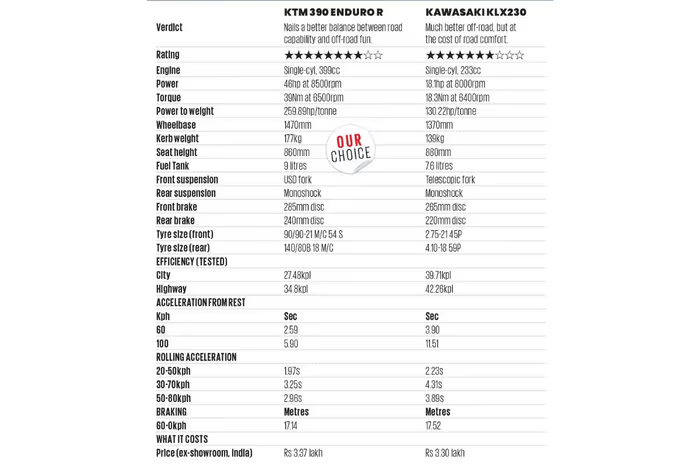
For an additional Rs 7,000 over the KLX230, the 390 Enduro R offers higher performance, sophisticated electronics, and versatility. It’s more physically demanding off-road, but with enough skill and commitment, it will go where the KLX can while simultaneously being a more accomplished road bike. Its biggest shortcoming is its suspension, but KTM will bring in the international-spec longer-travel variant soon, albeit at a higher cost. For the small price delta between the two bikes, KTM’s 390 Enduro R makes a much stronger case for itself and is the better contender for a single-bike garage.
Also see: KTM 390 Adventure vs Royal Enfield Himalayan comparison review

